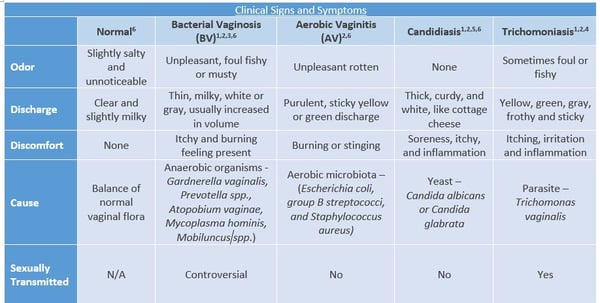In the U.S. and in other parts of the world, women’s health is a top concern for many physicians. Unfortunately, according to WHO, while poverty is a barrier to positive health outcomes for both men and women, poverty tends to yield a higher burden on women and girls’ health. ScienceDirect reports that in developing countries BV is common in the general population, affecting approximately half of all women. For the best outcomes around the world, proper education on the different presentations, symptoms, and types of vaginitis is essential
positive health outcomes for both men and women, poverty tends to yield a higher burden on women and girls’ health. ScienceDirect reports that in developing countries BV is common in the general population, affecting approximately half of all women. For the best outcomes around the world, proper education on the different presentations, symptoms, and types of vaginitis is essential
Vaginitis is one of the most common problems in women’s health worldwide; in fact, most women will have some kind of vaginitis at least once in their lives. Vaginitis is a name for swelling, itching, burning, or infection in the vagina that can be caused by several different germs. Diagnosis can be challenging and if it’s not diagnosed and treated properly, vaginitis may lead to further complications.
According to Prof. Werner Mendling Prof. Dr. med. Specialist in Gynecology and Obstetrics, who along with Sekisui Diagnostics recently presented a webinar on this topic, clinicians need to be aware of the different presentations of vaginal discharge and how to approach treatment management so that the symptoms can be treated accordingly to the etiology.
Why the Diagnosis Matters
It seems obvious that both physicians and patients want an accurate diagnosis no matter what the ailment, but in the case of vaginitis, inaccurate and inconsistent diagnosis can lead to unfortunate outcomes. Health risks can include but are not limited to:
- Preterm or low birth-weight babies
- Increased risk of sexually transmitted infections such as HIV
- Increased risk of pelvic inflammatory disease
The situation is further complicated as a result of overlapping clinical symptoms that make it difficult to accurately diagnose vaginitis alone.

Because symptoms can overlap, as shown above, diagnosis of these conditions is based upon clinical symptoms, examination, pH of the flora, the microscopic findings of the vaginal secretions, culture, and, if available, immunochemistry or molecular laboratory tests. Microscopy of each of these can be subjective and challenging. In the case of Trichomoniasis, one must see the live organism in order to call a positive result.
The Remedy for What Ails You
An accurate diagnosis is also important because the treatment a physician prescribes varies based on the type of vaginitis. According to Dr. Mendling, the treatment for BV and Trichomoniasis is the following:
- Metronidazole 400–500 mg orally twice daily for five to seven days, or Metronidazole 2 g orally in a single dose, or
- Tinidazole 2 g orally in a single dose
- 2% clindamycin cream 5g intravaginally for 7 - 21 days
- Oral - Fluconazole 150mg as a single dose
- Oral - Itraconazole 200mg twice daily for one day
- Intravaginal - Clotrimazole vaginal tablet 500mg as single dose or 200mg once daily for 3 days
The Importance of Women’s Health
Sekisui Diagnosis helps support women’s health by offering a point-of-care diagnostic test for Bacterial Vaginosis (OSOM® BVBlue) and Trichomonas vaginalis (OSOM® Trichomonas), which are the most common types of vaginosis. The OSOM BVBLUE Test detects elevated vaginal fluid sialidase activity, an enzyme produced by bacterial pathogens associated with bacterial vaginosis including Gardnerella, Bacteroides, Prevotella, and Mobiluncus. It requires one minute of hands-on-time and 10 minutes of read time, and its instant color change provides clear, easy-to-read results. OSOM Trichomonas is the only CLIA-waived rapid test for the detection of Trichomoniasis. It detects the antigen, and thus does not require live organisms, and offers results in 10 minutes or less.
(OSOM® Trichomonas), which are the most common types of vaginosis. The OSOM BVBLUE Test detects elevated vaginal fluid sialidase activity, an enzyme produced by bacterial pathogens associated with bacterial vaginosis including Gardnerella, Bacteroides, Prevotella, and Mobiluncus. It requires one minute of hands-on-time and 10 minutes of read time, and its instant color change provides clear, easy-to-read results. OSOM Trichomonas is the only CLIA-waived rapid test for the detection of Trichomoniasis. It detects the antigen, and thus does not require live organisms, and offers results in 10 minutes or less.
In 2016, nine women's health leaders from across the USA participated in a meeting to discuss the landscape of Bacterial Vaginosis. They concluded that a greater awareness of BV is needed across various groups, including women and healthcare providers. They also stated that providers should adopt point‐of‐care tests to accurately diagnose BV. These statements can clearly be applied to all types of vaginitis. In 2018, WHO updated its guideline on the management of vaginal discharge. In order to treat one of the most common ailments in women’s health, clinicians should keep up-to-date on the different presentations of vaginal discharge and how to approach properly diagnosing and treating vaginitis at the point of care.
The 2018 European (IUSTI/WHO) guideline on the management of vaginal discharge mentions the OSOM® BVBLUE® test amongst other methods of diagnosing BV and describes the test’s sensitivity compared to microscopy. Similarly, the OSOM® Trichomonas rapid test is mentioned in the guidelines as an available point of care test and its sensitivity and specificity are described.
1 https://www.aafp.org/afp/2000/0901/p1095.html
2 https://www.verywellhealth.com/bacterial-vaginosis-diagnosis-3132745
3 https://www.cdc.gov/std/tg2015/bv.htm
4 https://www.cdc.gov/std/tg2015/trichomoniasis.htm
5 https://www.cdc.gov/std/tg2015/candidiasis.htm
6 https://www.ncbi.nlm.nih.gov/pmc/articles/PMC4437757/?report=printable



Share Article